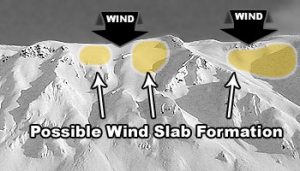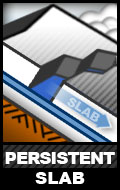Avalanche Danger Forecast
Issued Thursday, January 28, 2021 at 1pm for the greater Anchorage area Western Chugach Mountains (i.e. Chugach State Park). View map of primary forecast area here.
Avalanche danger will fluctuate within the moderate spectrum through this forecast period.
Friday brings the chance for a few inches of new snow and easterly winds that may be capable of loading leeward terrain in the upper elevations and creating fresh, small wind slabs on leeward aspects.
Saturday is expected to bring clearing skies and generally benign weather. Watch for localized wind loading and small wind slab development in the upper elevations from northerly winds.
Sunday is expected to be another dry day with sunshine. Further subtle wind loading and fresh, small wind slab development on leeward terrain in the upper elevations is possible.
The persistent slab problem lurks! While unlikely, it’s an unpredictable problem. See discussion below for further info.
Mountain Weather:
Friday: cloudy with a chance of light snow, alpine temps in the lower 20s, light to moderate easterly wind.
Saturday: generally sunny, alpine temps in the teens to lower 20s, light to moderate northerly wind.
Sunday: generally sunny, alpine temps in the single digits to lower teens, light to moderate wind.
Discussion:
The past forecast period provided an amazing window for enjoying very high quality Western Chugach powder snow and sunshine. This forecast period, while not quite as sunny, is expected to serve up more great powder skiing with generally benign mountain weather.
Small, fresh winds slabs will be the primary, and most likely triggered, avalanche problem. But, especially considering an example from Tuesday, the persistent slab problem should be on everyone’s radar (especially if recreating in typically drier areas of Chugach State Park from South Fork Eagle River north to the Knik River).
On Sunday, as skies cleared and the recent storm that delivered several inches of new snow to the alpine departed, we skied a WSW facing run starting from ~3600′ in the South Fork Eagle River area without incident. The next day, others followed our tracks down this line. Again on Tuesday, another party went to ski this line. The first skier in this party skied the line without incident. The second skier in that party triggered a persistent slab (SS-ASu-D2-R2-O) from ~3500′ WSW aspect that ran over 1000′ (click the images below to enlarge):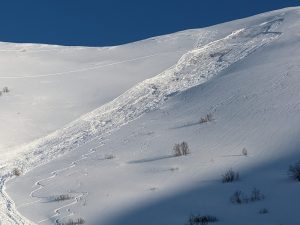

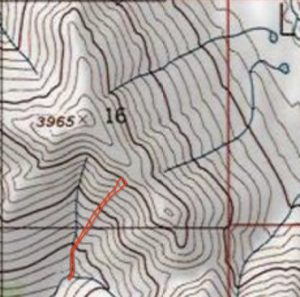
We traveled across all aspects and elevations in the South Fork area Sunday and Tuesday, the Arctic Valley area Monday, and the Front Range Wednesday. Nowhere in our travels did we experience any red flags or obvious signs of instability (except subtle, active wind loading in the upper elevations Tuesday and Wednesday), yet the unpredictable and tricky persistent slab problem lurks.
In other news, widespread surface hoar developed Sunday-Monday but seems to have been generally dismantled in the mid to upper elevations by moderate winds Tuesday-Wednesday. That said, it will be important to keep this surface hoar in mind if traveling on steep and wind-sheltered terrain as isolated pockets of it may have survived intact and be buried by Thursday-Friday snowfall.
Avalanche Problems:
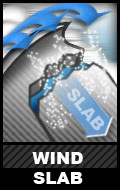 Human triggered wind slabs up to D2 in size are possible above 2500′ on leeward terrain steeper than 35º.
Human triggered wind slabs up to D2 in size are possible above 2500′ on leeward terrain steeper than 35º.
Winds will shift through this forecast period from easterly (Friday) to northerly (Saturday). At the upper elevations, moderate winds may be capable of building fresh, small wind slabs on leeward aspects.
As winds will shift (and considering that the terrain of the forecast area channels winds in varying directions), it will be important to pay close attention to wind scouring and loading patterns in the upper elevations in order to better understand where potentially reactive wind slabs may exist.
Fresh wind slabs this weekend are generally expected to be small soft slabs.
Wind slabs are most likely to exist below corniced areas and along the lee sides of ridges and cross-loaded features like gullies:
Active wind loading, recent avalanches, and shooting cracks are red flag indicators of wind slab danger. However, these indicators may not be present through this forecast period.
Relatively densely-packed (“punchier” feeling) snow and pockets of deeper snow (especially with a bulbous or fat appearance) are expected to be the most reliable indicators of wind slabs this forecast period. If you look closely at the snow surface, you may be able to distinguish areas where wind slabs exist due to the snow having a more textured, densely-packed, consolidated, and/or cohesive appearance.
Pole probing and hand pits are a quick and effective means of assessing this problem as you travel. Use pole probing to quickly feel out areas of denser, wind-packed snow overlying looser and weaker snow. Use hand pits to quickly assess how near-surface layers of snow are bonded.
Digging a snowpit and conducting a compression test and/or extended column test will provide an even better assessment of bonding and instability before you travel on terrain of consequence.
You can also assess wind slab instability via safer “test slopes” that are representative of higher consequence terrain.
Human triggered persistent slabs up to D2.5 in size are possible on all aspects above 2500′ where the terrain is steeper than 35º.
This is a low probability but potentially high consequence avalanche problem. While predominantly dormant, these persistent slabs are unpredictable. Review the discussion above for an example of this from Tuesday, January 26.
Such hard slabs (these avalanches are likely to break deeper down in the snowpack where layers are much denser than near the surface) have a tendency to release above and around a human trigger, rather than at the trigger’s feet, which can make escape difficult. In addition, hard slab avalanche debris is more likely to cause trauma than debris from soft snow.
Diverse and widespread persistent weak layers exist in the snowpack. Faceted snow exists above and below crusts in some areas, sandwiched between wind packed layers in many areas, and a basal weak layer of advanced facets and depth hoar is widespread.
While they aren’t expected to be present this forecast period, always be on the lookout for red flag warnings of persistent slab danger: recent avalanches, collapsing (aka “whumphing“), and shooting cracks. Understanding this avalanche problem where you intend to travel will require in-depth analysis: digging snowpits, conducting instability tests, and analyzing snowpack stratigraphy (layering).
Terrain management is simply the best way to avoid tricky avalanche problems: don’t expose yourself to terrain capable of producing a large and dangerous persistent slab.
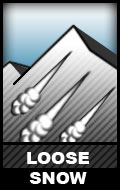 Both natural and human triggered dry loose snow avalanches are possible above 3000′ on all aspects where the terrain is steeper than 38º.
Both natural and human triggered dry loose snow avalanches are possible above 3000′ on all aspects where the terrain is steeper than 38º.
There is still a lot of loose snow around Chugach State Park and some sheltered upper elevation areas are especially deep. We encountered high volume human triggered sluffing on steep terrain in the upper elevations as recently as Wednesday while doing a big tour in the Front Range to survey conditions. If the upper elevations receive more snow, as forecast for Thursday and Friday, this will add even more volume to loose snow avalanches.
While these relatively small avalanches (D1) aren’t much of a concern in regard to burial, they do have the potential to cause a fall or loss of control. While not likely, it’s possible that a loose snow avalanche could trigger a larger wind or persistent slab as it descends a slope and gains mass.
Don’t let a loose snow avalanche catch you off guard. Manage your sluff if descending steep terrain via ski or snowboard. If it happens to be windy and you’re climbing steep and/or exposed terrain, be mindful of the potential for heavy spindrift.
Before traveling on or under terrain that has the potential to avalanche think about the consequences, and have a plan (to escape the avalanche, for re-grouping, and rescue).
Always be mindful of terrain traps that can make even a small avalanche deadly.
Click the hyperlinks and icons to learn more.


